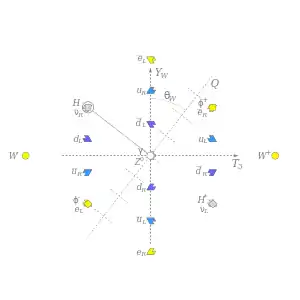Weinberg angle
The Weinberg angle or weak mixing angle[1] is a parameter in the Weinberg–Salam theory of the electroweak interaction, part of the Standard Model of particle physics, and is usually denoted as θW. It is the angle by which spontaneous symmetry breaking rotates the original
W0
and B0 vector boson plane, producing as a result the
Z0
boson, and the photon.[2]
.svg.png.webp)

It also gives the relationship between the masses of the W and Z bosons (denoted as mW and mZ),
The angle can be expressed in terms of the and couplings (weak isospin g and weak hypercharge g′, respectively),
- and
The electric charge is then expressible in terms of it, e = g sin θW = g′ cos θW; see the Figure.
As the value of the mixing angle is currently determined empirically, it has been mathematically defined as[3]
The value of θW varies as a function of the momentum transfer, Q, at which it is measured. This variation, or 'running', is a key prediction of the electroweak theory. The most precise measurements have been carried out in electron–positron collider experiments at a value of Q = 91.2 GeV/c, corresponding to the mass of the Z boson, mZ.
In practice the quantity sin2θW is more frequently used. The 2004 best estimate of sin2θW, at Q = 91.2 GeV/c, in the MS scheme is 0.23120 ± 0.00015, which averages over measurements made in different processes and at different detectors. Atomic parity violation experiments yield values for sin2θW at smaller values of Q, below 0.01 GeV/c, but with much lower precision. In 2005 results were published from a study of parity violation in Møller scattering in which a value of sin2θW = 0.2397 ± 0.0013 was obtained at Q = 0.16 GeV/c, establishing experimentally the 'running' of the weak mixing angle. These values correspond to a Weinberg angle of ~30°. LHCb measured in 7 and 8 TeV proton-proton collisions an effective angle of sin2(θWeff) = 0.23142, though the value of Q for this measurement is determined by the partonic collision energy, which is close to the Z boson mass.
CODATA 2018[4] gives the value
- .
Note, however, that the specific value of the angle is not a prediction of the standard model: it is an open, unfixed parameter. However, it is constrained and predicted through other measurements of Standard Model quantities. At this time, there is no generally accepted theory that explains why the measured value is what it is.
References
- Glashow, Sheldon (February 1961). "Partial-symmetries of weak interactions". Nuclear Physics. 22 (4): 579–588. doi:10.1016/0029-5582(61)90469-2.
- T. P. Cheng; L. F. Li (2006). Gauge theory of elementary particle physics. Oxford University Press ISBN 0-19-851961-3. pp 349-355
- L. B. Okun (1982). Leptons and Quarks. North-Holland Physics Publishing. p. 214. ISBN 0-444-86924-7.
- "2018 CODATA Value: weak mixing angle". The NIST Reference on Constants, Units, and Uncertainty. NIST. 20 May 2019. Retrieved 2019-05-20.
- 2019 PDG (Particle Data Group) Review, revised March 2018 by J. Erler and A. Freitas.
- E158: A Precision Measurement of the Weak Mixing Angle in Møller Scattering
- Q-weak: A Precision Test of the Standard Model and Determination of the Weak Charges of the Quarks through Parity-Violating Electron Scattering
